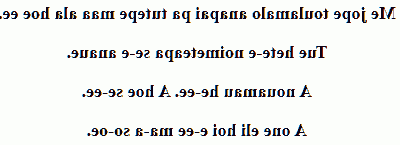Pawaia love poem
Toula
Me jope toulamalo anapai pa tutepe maa ala hoe ee
Tue hete-e noimeteapa se-e anaue
A nouamau he-ee. A hoe se-ee
A one eli hoi e-ee ma-a so-oe

Other version
à jope toulalo
Pa ã hoi eesēūēee ã Mee alie,
Mõ ã toula suaoa pa ãjope te heetee ãī teo hõ Tolo aleeūee
Ãlãlēū teo Mõ ã ã'ã aee sõūee.

→ French poem ←
Pawaia and their language
My love poem translated into Pawaia, a language spoken by approximately 5,000 people in the Gulf, Southern Highlands and Simbu (Karimui District) provinces, in Papua New Guinea.
Even though there is only about 7% vocabulary similarity with Kuman, Pawaia has been classified in the group of Trans-New Guinea languages. Some connect it with the Teberan group.
The alternatives to designate Pawaia with its dialects are: Pavaia, Sira, Hauruha, Yasa, Tudahwe, Aurama, Turoha, Uri, Pawaian.
The Pawaia practice burning and cultivation (sago, palm trees). They also raise animals (pigs) for the subsistence of their families, so these livestock and crops are relatively small.
They also practice fishing, hunting (birds), gathering, and the forest also offers them everything they may need to make tools and everyday objects.
The Pawaia, who are semi-nomads, continue to have a life characterized by rhythmic mobility:
- through their subsistence activities,
- by conflicts with other groups,
- as well as by their duties (crops, hunting), towards their wife's family (exchanges between family connections).
Their distribution over three provinces of Papua New Guinea gives less weight in each of them, and it is not wrong to see how they are neglected.